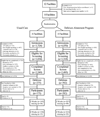Randomized trial of a delirium abatement program for postacute skilled nursing facilities
- PMID: 20487083
- PMCID: PMC2924954
- DOI: 10.1111/j.1532-5415.2010.02871.x
Randomized trial of a delirium abatement program for postacute skilled nursing facilities
Abstract
Objectives: To determine whether a delirium abatement program (DAP) can shorten duration of delirium in new admissions to postacute care (PAC).
Design: Cluster randomized controlled trial.
Setting: Eight skilled nursing facilities specializing in PAC within a single metropolitan region.
Participants: Four hundred fifty-seven participants with delirium at PAC admission.
Intervention: The DAP consisted of four steps: assessment for delirium within 5 days of PAC admission, assessment and correction of common reversible causes of delirium, prevention of complications of delirium, and restoration of function.
Measurements: Trained researchers screened eligible patients. Those with delirium defined according to the Confusion Assessment Method were eligible for participation using proxy consent. Regardless of location, researchers blind to intervention status re-assessed participants for delirium 2 weeks and 1 month after enrollment.
Results: Nurses at DAP sites detected delirium in 41% of participants, versus 12% in usual care sites (P<.001), and completed DAP documentation in most participants in whom delirium was detected, but the DAP intervention had no effect on delirium persistence based on two measurements at 2 weeks (DAP 68% vs usual care 66%) and 1 month (DAP 60% vs usual care 51%) (adjusted P> or =.20). Adjusting for baseline differences between DAP and usual care participants and restricting analysis to DAP participants in whom delirium was detected did not alter the results.
Conclusion: Detection of delirium improved at the DAP sites, but the DAP had no effect on the persistence of delirium. This effectiveness trial demonstrated that a nurse-led DAP intervention was not effective in typical PAC facilities.
Trial registration: ClinicalTrials.gov NCT00182936.
Conflict of interest statement
The editor in chief has reviewed the conflict of interest checklist provided by the authors and has determined that the authors have no financial or any other kind of personal conflicts with this paper. Dr. Marcantonio is a Paul Beeson Physician Faculty Scholar in Aging Research. The authors retained full autonomy in the preparation of this manuscript.
Figures

Comment in
-
Paper geriatrics.J Am Geriatr Soc. 2010 Jun;58(6):1184-6. doi: 10.1111/j.1532-5415.2010.02876.x. J Am Geriatr Soc. 2010. PMID: 20722850 No abstract available.
-
Effective treatment of delirium is difficult but not impossible.J Am Geriatr Soc. 2011 Jan;59(1):167-8; author reply 168-9. doi: 10.1111/j.1532-5415.2010.03204.x. J Am Geriatr Soc. 2011. PMID: 21226691 No abstract available.
References
-
- Inouye SK. Current concepts: Delirium in older persons. New Eng J Med. 2006;354:1157–1165. - PubMed
-
- Levkoff SE, Evans DA, Liptzin B, et al. Delirium: the occurrence and persistence of symptoms among elderly hospitalized patients. Arch Int Med. 1992;152:334–340. - PubMed
-
- Medicare Payment Advisory Commission (MEDPAC) A Data Book: Healthcare Spending and the Medicare Program: MEDPAC. 2005.
-
- Kiely DK, Bergmann MA, Murphy KM, et al. Delirium among newly admitted post-acute facility patients: Prevalence, symptoms, and severity. J Gerontol A Biol Sci Med Sci. 2003;58A:441–445. - PubMed
Publication types
MeSH terms
Associated data
Grants and funding
LinkOut - more resources
Full Text Sources
Medical

